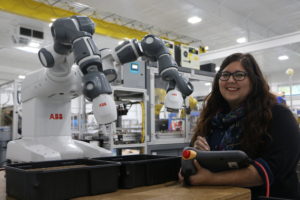 You have probably heard of cobots, as they are a growing trend in today’s automation manufacturing industries. Cobots, or collaborative robots work in partnership with employees. Unlike traditional industrial robots, cobots are designed to work with humans and not for humans. Although gaining popularity, many people do not fully understand the differences between cobots and robots.
You have probably heard of cobots, as they are a growing trend in today’s automation manufacturing industries. Cobots, or collaborative robots work in partnership with employees. Unlike traditional industrial robots, cobots are designed to work with humans and not for humans. Although gaining popularity, many people do not fully understand the differences between cobots and robots.
4 Key Differences of Cobots
- Partnership with Humans: A cobot can act as an assistant to a human operator and is typically used in applications working alongside human operators. Traditional robots are programmed to complete an automated task with very little or no human interaction. They aren’t designed with human safety as a key priority they just do their task. Accidents are prevented using safety fencing and cages.
- Safety: Cobots are equipped with features allowing seamless collaboration. Many cobots are designed with detection features that allow them operate in the same envelope as humans. They are able to immobilize with the slightest touch preventing injury to the operator or any person nearby. This eliminates the need for safety fencing and cages, since the cobot is designed to work around and collaborate with humans.
- Ease of Use: Collaborative robots are very easy to program and are capable of learning quickly. Unlike traditional industrial robots that require advanced programming skills, cobots can be given work instructions without coding. Operators are able to reprogram cobots and use them for a variety of tasks.
- Functionality: Unlike traditional robots, cobots can easily be moved and utilized in different areas of production. Most can be mounted on any surface – horizontal, vertical, on the ceiling. They are often light enough to be carried by just one person, which is not usually the case with traditional industrial robots.
What is Right for You?
There are many questions that have to be addressed in deciding whether an industrial robot or cobot is best suited for your project. What are your automation goals, how much space do you have for automation equipment, are your processes fixed or do they change regularly? We can help you answer these questions and determine whether a cobot or traditional robot is right for you. Contact us today and request a quote for your custom solution.